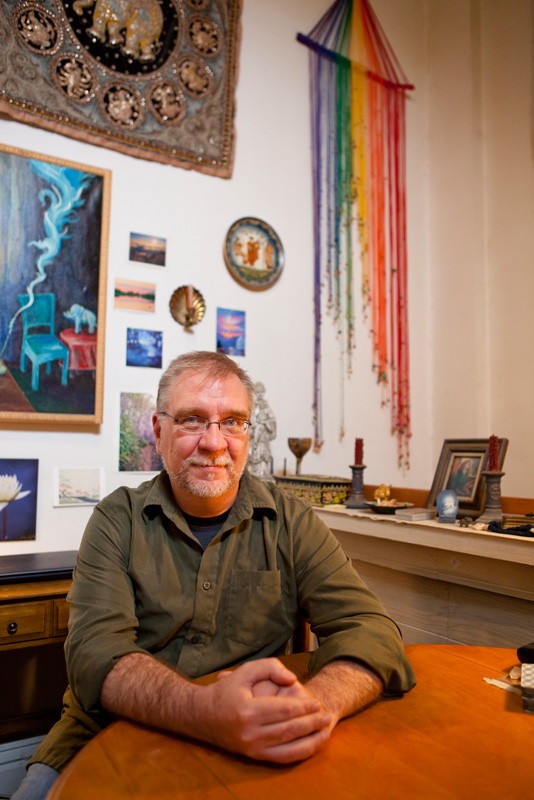Twenty-five years of Pride
GLBTTQ community leaders reflect on what Pride means 25 years after it all started
The 25th anniversary of the Pride Winnipeg Festival (May 25 to June 3) is an opportunity for members of the local gay, lesbian, bisexual, transgender, two-spirit and queer (GLBTTQ) community to reflect on how far the community has progressed towards acceptance since the event launched in 1987.
The evolution of the event itself towards a week-long festival parallels this development.
“The balloons shine a little brighter now,” said Barb Burkowski, the chair of the Pride organizing committee.
Organized in response to Manitoba’s human rights legislation passed in 1987 by the provincial government, the first pride march - far smaller in scope and scale than the current festival - was an opportunity for GLBTTQ people in Winnipeg to celebrate a historic victory.
In spite of this, Burkowski notes that the atmosphere of the time prevented uninhibited jubilation.
“What they were marching for and being a part of it for, how they were actually brave enough to come and walk the streets at that time, is incredibly different than what is happening now,” she said. “I do not think it is comparable.”
University of Winnipeg Students’ Association LGBT director Dayne Moyer echoes this by mentioning how some of the original marchers even “had bags on their heads to remain anonymous.”
Societal changes mirror changes in the parade itself.
Burkowski points to a smattering of GLBTTQ meeting places in the 1980s such as Gio’s and Purdy’s as being some of the few places where the community could feel welcome in a social setting.
“These are places where they could gather together, be safe and be themselves,” she said. “A lot of these meeting places are where the strength and growth came from because when you can sit down and talk about yourself and your life, you start to gain strength and feel comfortable.”
Progress continued to be made as a number of clinics and resource centres grew out of these gathering spots.
Although victories such as the introduction of gay marriage are easier to point to, the yardsticks have also moved closer towards social acceptance for GLBTTQ people.
By 2012, GLBTTQ couples can frequent restaurants or even straight bars in Winnipeg without facing the stigmas of the past.
“People were spit on and kicked out of families with no place to go (in the 1980s),” Burkowski said. “We forget (that).”
Despite the broad recognition that significant progress has been made over 25 years, there are varying views as to where Winnipeg now stands as far as acceptance for gays and lesbians.
“People are still not comfortable coming out in their families, particularly in cultures from countries where (homosexuality is forbidden),” Burkowski said. “There is also still trouble in schools.”
Moyer echoes this thought.
“When you see so many people out at the parade having a good time, you sort of forget about major issues that we still need to address. ... If (youth) know that in their family or in their community it is not OK to be gay, they do not have as much support.”
Moyer believes that in certain circumstances, it can even be less safe for youth who come out because of the internalization that the situation has improved to the point where it does not matter.
“ What they were marching for and being a part of it for, how they were actually brave enough to come and walk the streets (in 1987), is incredibly different than what is happening now. I do not think it is comparable.
Barb Burkowski, chair, Pride Winnipeg committee
Trevor Thorkelson, a participant in the first pride march in 1987 recalls what it was like to march on that day.
“I had an obligation to march on behalf of all the people who could not or would not. It was a show of solidarity,” he said.
With the intensive media coverage and nervous excitement of the marchers, Thorkelson recognized that he was participating in a truly historic moment for the GLBTTQ community.
Twenty-five years later, Thorkelson still believes in the power of Pride.
Rather than seeing the current Pride celebration as a fun diversion, Thorkelson believes it is still very politically relevant.
“Why don’t you take a walk through Polo Park holding the hand of your best friend of the same sex and see how comfortable you feel?” he asked.
One of the points of disagreement over the festival itself is the debate over whether or not Pride is a kind of gay holiday, a political protest or something in between.
Moyer argues that despite the need for the community to celebrate together, more emphasis on the political nature of the event is needed because of the issues that are still outstanding.
“I think that there is a little bit of a loss of direction. A lot of the floats in other parades have a specific political message and we don’t really do that in Winnipeg,” Moyer said.
Burkowski on the other hand is more optimistic that the political flavour has not been lost, pointing to how this year features an illumination of the Legislature with the colours of the gay pride flag.
“I see it as a celebration of political gains,” Burkowski said.
Published in Volume 66, Number 27 of The Uniter (May 30, 2012)







